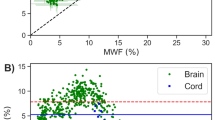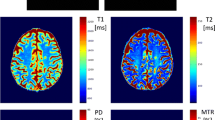Abstract
The aim of the current study was to perform T2 relaxation time measurements in multiple sclerosis (MS) patients and correlate them with magnetization transfer ratio (MTR) measurements, in order to investigate in more detail the various histopathological changes that occur in lesions and normal-appearing white matter (NAWM). A total number of 291 measurements of MTR and T2 relaxation times were performed in 13 MS patients and 10 age-matched healthy volunteers. Measurements concerned MS plaques (105), NAWM (80), and “dirty” white matter (DWM; 30), evenly divided between the MS patients, and normal white matter (NWM; 76) in the healthy volunteers. Biexponential T2 relaxation-time analysis was performed, and also possible linearity between MTR and mean T2 relaxation times was evaluated using linear regression analysis in all subgroups. Biexponential relaxation was more pronounced in “black-hole” lesions (16.6%) and homogeneous enhancing plaques (10%), whereas DWM, NAWM, and mildly hypointense lesions presented biexponential behavior with a lower frequency(6.6, 5, and 3.1%, respectively). Non-enhancing isointense lesions and normal white matter did not reveal any biexponentional behavior. Linear regression analysis between monoexponential T2 relaxation time and MTR measurements demonstrated excellent correlation for DWM(r=−0.78, p<0.0001), very good correlation for black-hole lesions(r=-0.71, p=0.002), good correlation for isointense lesions(r=−0.60, p=0.005), moderate correlation for mildly hypointense lesions(r=−0.34, p=0.007), and non-significant correlation for homogeneous enhancing plaques, NAWM, and NWM. Biexponential T2 relaxation-time behavior is seen in only very few lesions (mainly on plaques with high degree of demyelination and axonal loss). A strong correlation between MTR and monoexponential T2 values was found in regions where either inflammation or demyelination predominates; however, when both pathological conditions coexist, this linear relationship is lost.






Similar content being viewed by others
References
Jackson JA, Leake DR, Schneiders NJ, Rolak LA, Kelley GR, Ford JJ, Appel SH, Bryan RN (1985) Magnetic resonance imaging in multiple sclerosis: results in 32 cases. Am J Neuroradiol 6:171–176
van der Knaap MS, Valk J (1995) Multiple sclerosis. In: van der Knaap MS, Valk J Magnetic resonance of myelin, myelination, and myelin disorders, 2nd edn. Springer, Berlin Heidelberg New York, pp 296–313
Fazekas F, Barkhof F, Filippi M, Grossman RI, Li DK, McDonald WI, McFarland HF, Paty DW, Simon JH, Wolinsky JS, Miller DH (1999) The contribution of magnetic resonance imaging to the diagnosis of multiple sclerosis. Neurology 53:448–456
Ormerod IE, Miller DH, McDonald WI, du Boulay EP, Rudge P, Kendall BE, Moseley IF, Johnson G, Tofts PS, Halliday AM et al. (1987) The role of NMR imaging in the assessment of multiple sclerosis and isolated neurological lesions: a quantitative study. Brain 110:1579–1616
Bruck W, Bitsch A, Kolenda H, Bruck Y, Stiefel M, Lassmann H (1997) Inflammatory central nervous system demyelination: correlation of magnetic resonance imaging findings with lesion pathology. Ann Neurol 42:783–793
Lucchinetti CF, Bruck W, Rodriguez M, Lassmann H (1996) Distinct patterns of multiple sclerosis pathology indicated heterogeneity in pathogenesis. Brain Pathol 6:259–274
Filippi M, Campi A, Dousset V, Baratti C, Martinelli V, Canal N, Scotti G, Comi G (1996) A magnetization transfer imaging study of normal-appearing white matter in multiple sclerosis. Neurology 17:1041–1049
van Buchem MA, McGowan JC, Kolson DL, Polansky M, Grossman RI (1996) Quantitative volumetric magnetization transfer analysis in multiple sclerosis: estimation of macroscopic and microscopic disease burden. Magn Reson Med 36:632–636
Gass A, Barker GJ, Kidd D, Thorpe JW, MacManus D, Brennan A, Tofts PS, Thompson AJ, McDonald WI, Miller DH (1994) Correlation of magnetization transfer ratio and clinical disability in multiple sclerosis. Ann Neurol 36:62–67
Dousset V, Grossman RI, Ramer KN, Schnall MD, Young LH, Gonzalez-Scarano F (1992) Experimental allergic encephalomyelitis and multiple sclerosis: lesion characterization with magnetization transfer imaging. Radiology 182:483–491
Tomiak MM, Rosenblum JD, Prager JM, Metz CE (1994) Magnetization transfer: a potential method to determine the age of multiple sclerosis lesions. Am J Neuroradiol 15:1569–1574
van Waessberghe JHTM, van Walderveen MAA, de Groot C, Ravid R, Lycklama à Nijeholt GJ, Kamphorst W, Barkhof F (1998) Postmortem correlation between axonal loss, MTR, and hypersensitivity on T1SE in MS. Proc ISMRM 2:1334
Larsson HBW, Christiansen P, Zeeberg I, Henriksen O (1992) In-vivo evaluation of the reproducibility of T1 and T2 measured in the brain of patients with multiple sclerosis. Magn Reson Imaging 10:579–584
Miller DH, Johnson G, Tofts PS, MacManus D, McDonald WI (1989) Precise relaxation time measurements of normal appearing white matter in inflammatory central nervous system disease. Magn Reson Med 11:331–336
Armspach J, Gounot D, Rumbach L, Chambron J (1991) In-vivo determination of multiexponentional T2 relaxation times in the brains of patients with multiple sclerosis. Magn Reson Imaging 9:107–113
Larsson HBW, Frederiksen J, Petersen J, Nordenbo A, Zeeberg I, Henriksen O, Olesen J (1989) Assessment of demyelination, edema and gliosis by in-vivo determination of T1 and T2 in the brain of patients with acute attack of multiple sclerosis. Magn Reson Med 11:337–348
Kidd D, Barker GJ, Tofts PS, Gass A, Thompson AJ, McDonald WI, Miller DH (1997) The transverse magnetization decay characteristics of longstanding lesions and normal-appearing white matter in multiple sclerosis. J Neurol 244:125–130
Mackay AL, Whittall KP, Adler J, Li D, Paty D, Graeb D (1994) In-vivo visualization of myelin water in brain by magnetic resonance. Magn Reson Med 31:673–677
Papanikolaou N, Maniatis V, Pappas J, Roussakis A, Efthimiadou R, Andreou J (2002) Biexponential T2 relaxation time analysis of the brain: correlation with magnetization transfer ratio. Invest Radiol 37:363–367
Poser CM, Paty DW, Scheinberg L, McDonald WI, Davis FA, Ebers GC, Johnson KP, Sibley WA, Silberberg DH, Tourtellotte WW (1983) New diagnostic criteria for multiple sclerosis: guidelines for research protocols. Ann Neurol 13:227–231
Graumann R, Oppelt A, Stetter E (1986) Multiple spin-echo imaging with a 2D Fourier method. Magn Reson Med 3:707–710
Nusbaum AO, Lu D, Tang CY, Atlas SW (2000) Quantitative diffusion measurements in focal multiple sclerosis lesions: correlations with appearance on TI-weighted MR images. Am J Roentgenol 175:821–825
Cercignani M, Inglese M, Pagani E, Comi G, Filippi M (2001) Mean diffusivity and fractional anisotropy histograms of patients with multiple sclerosis. Am J Neuroradiol 22:952–958
Falini A, Calabrese G, Filippi M, Origgi D, Lipari S, Colombo B, Comi G, Scotti G (1998) Benign vs secondary-progressive multiple sclerosis: the potential role of proton MR spectroscopy in defining the nature of disability. Am J Neuroradiol 19:223–229
Gareau PJ, Rutt BK, Karlik SJ, Mitchell JR (2000) Magnetization transfer and multicomponent T2 relaxation measurements with histopathologic correlation in an experimental model of MS. J Magn Reson Imaging 11:586–595
Graham SJ, Sanchev PL, Bronskil MJ (1996) Criteria for analysis of multicomponent tissue T2 relaxation data. Magn Reson Med 35:370–378
Poon CS, Henkelman RM (1992) Practical T2 quantitation for clinical applications. J Magn Reson Imaging 2:541–553
Vavasour IM, Whittall KP, MacKay AL, Li DK, Vorobeychik G, Paty DW (1998) A comparison between magnetization transfer ratios and myelin water percentages in normals and multiple sclerosis patients. Magn Reson Med 40:763–768
Barnes D, McDonald WI, Johnson G, Tofts P, Landon D (1987) Quantitative nuclear magnetic resonance imaging: characterization of experimental cerebral oedema. J Neurol Neurosurg Psychiatry 50:25–133
Naruse S, Horikawa Y, Tanaka C, Hirakawa K, Nishikawa H, Yoshizaki K (1982) Proton nuclear magnetic resonance studies on brain edema. J Neurosurg 56:747–752
Loevner LA, Grossman RI, Cohen JA, Lexa FJ, Kessler D, Kolson DL (1995) Microscopic disease in normal-appearing white matter on conventional MR images in patients with multiple sclerosis: assessment with magnetization transfer ratio measurements. Radiology 196:511–515
Barkhof F, McGowan JC, van Waesberghe JH, Grossman RI (1998) Hypointense multiple sclerosis lesions on T1-weighted spin-echo magnetic resonance images: their contribution in understanding multiple sclerosis evolution. J Neurol Neurosurg Psychiatry 64 (Suppl 1):S77–S79
Loevner LA, Grossman RI, McGowan JC, Ramer KN, Cohen JA (1995) Characterization of multiple sclerosis plaques with T1-weighted MR and quantitative magnetization transfer. Am J Neuroradiol 16:1473–1479
Stanisz GJ, Kecojevic A, Bronskill MJ, Henkelman RM (1999) Characterizing white matter with magnetization transfer and T2. Magn Reson Med 42:1128–1136
Barbosa S, Blumhardt LD, Roberts N, Lock T, Edwards RH (1994) Magnetic resonance relaxation time mapping in multiple sclerosis: normal-appearing white matter and the invisible lesion load. Magn Reson Imaging 12:34–43
Lacomis D, Osbakken M, Gross G (1988) Spin lattice relaxation (T1) times of cerebral white matter in multiple sclerosis. Magn Reson Med 7:43–55
Author information
Authors and Affiliations
Corresponding author
Rights and permissions
About this article
Cite this article
Papanikolaou, N., Papadaki, E., Karampekios, S. et al. T2 relaxation time analysis in patients with multiple sclerosis: correlation with magnetization transfer ratio. Eur Radiol 14, 115–122 (2004). https://doi.org/10.1007/s00330-003-1946-0
Received:
Revised:
Accepted:
Published:
Issue Date:
DOI: https://doi.org/10.1007/s00330-003-1946-0




